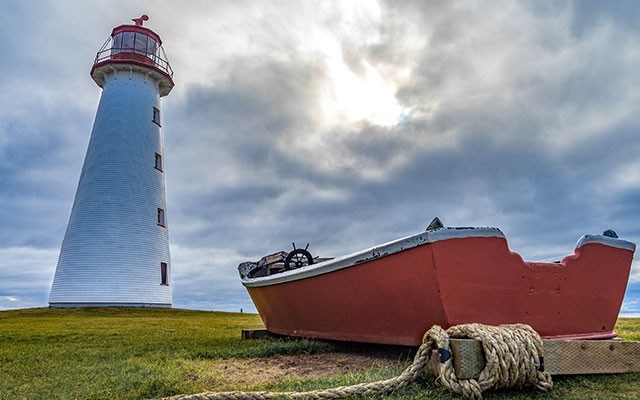No matter how you view Prince Edward Island — from the wind farms on its northern tip that have transformed Canada's tiniest province into a net energy exporter, to the velvety farm fields that define its lush landscape, to the national park anchored by author Lucy Maud Montgomery's beloved Green Gables farm — when Pique visited earlier this summer there were more shades of green on display than anywhere east of B.C.'s temperate rainforest, including the green tea ice cream served up at the original Cow's Creamery.
Care to see green for yourself? September presents an ideal time for a week-long getaway to discover that the saying "small is beautiful" might just have been coined to describe the 224-kilometre-long archipelago known to Mi'kmaq First Nations as "Cradled in the Waves." For starters, the scale of the crescent-shaped island invites easy day-trip exploration by car or bike. Atlantic Ocean shorelines on P.E.I.'s east and west coasts lie no more than 60 kilometres apart. Now that's compact.
By September, the annual wave of 180,000 visitors (far in excess of the island's resident population of 144,000) crests. Accommodations free up and, best of all, the nascent month-long Fall Flavours Festival gets underway. Much as the fruitful partnerships between Whistler restaurateurs and Pemberton growers have brought the farm-to-fork concept to the culinary fore locally, so too has the advent of a new generation of small-scale, land- and aqua-based food operations meshed with a burgeoning roster of island chefs, such as author and television presenter Michael Smith.
Pique spoke with Smith during a tour of his upscale waterfront resort, The Inn at Bay Fortune. "I arrived here in 1992 searching for a place to meet farmers and plant a garden," he said. "In the past decade there's been an epidemic of small producers tip-to-tip on this island. I can't keep track of them." Smith went on to spell out the fundamentals that shape his culinary credo. "First, everything we serve that we don't already raise on our eight-acre farm is locally sourced, right down to canola oil. We don't use olive oil. Secondly, we cook everything with hardwood gathered in our forest. Most importantly, we serve dinner in a family-style feast format, shoulder-to-shoulder with strangers, which allows our guests to connect with each other." Pique discovered that one of the team who work alongside Smith in front of the eight-metre-long brick hearth was ex-Whistler chef Brian Thibodeau. "I wanted to do a coast-to-coast comparison," said the former Araxi staffer, "and I've certainly found it here as a member of Michael's 'Fire Brigade.'"
Locally sourced seafood doesn't come much handier than from lobster boats moored at ports such as Bay Fortune and North Rustico, both originally settled by Acadians in the 1700s. The May-June catch was wrapping when we visited; another two-month opening, coincident with the Fall Flavours Festival, runs through September. These days, lobsters fetch record prices and, pardon the pun, trawlers are on a roll. (Lobster rolls are an island specialty.) In search of local wisdom — always a good bet on P.E.I. — Pique spent time checking traps with Riley Lavandier, a deckhand on Georgetown-based Tranquility Cove Adventures. His advice? "The tastiest are one-and-three-quarter pounders. Any larger and they're less flavourful and chewier. Look for ones with two long antennae as it means they haven't been in the tank long."
When it comes to defining the intangible essence of a wine's taste, the term frequently employed is terroir — the reflection of the natural environment's influence on the flavour of a grape. In the case of seafood, meroire would be an appropriate choice. Talk to any oyster farmer on P.E.I. and you'll hear the same story: all oysters cultivated on the island are the Malpeque variety. Yet, with over one thousand growing sites dotted along its east and west coasts, flavours can and do vary.
"Every different way of growing and every different place oysters are cultivated produces a different flavour" veteran shucker George Dowdle explained while skilfully opening plum-sized examples freshly drawn from his intertidal lease on the French River.
"Thanks to a nearby underwater artesian spring, my oysters have a salty, sweet taste. The market's changing. The next generation is embracing oysters — and lobsters too — which is good for me after being stagnant for years."
Dowdle also noted that new growing techniques have shortened the amount of time needed to rear oysters from five to three years and raised the recovery rate from as low as two percent to an astounding 98 per cent. "It's a global industry now," said the 27-year veteran. "Innovation comes from Australia to Ireland. We're all learning from each other. This is the way of the future."
There's no better benchmark by which to measure the quality of P.E.I. seafood than the bowls of chowder on offer everywhere. As our visit progressed, the name of one restaurant in particular kept popping up when the subject surfaced: Point Prim. As luck would have it, the chowder house and oyster bar lies just off the road to the Wood Islands slip from where ferry service sails to Nova Scotia. (The island is also linked with New Brunswick by the Confederation Bridge). If one must leave "Food Island," a bowl of this creamy ambrosia is definitely the way to go.
Access:
For travel information on P.E.I., visit www.tourismpei.com. Details on the Fall Flavours Festival are posted at www.fallflavours.ca. View Michael Smith's Inn at Bay Fortune at innatbayfortune.com. A good source of information on P.E.I.'s food scene is the periodical Salty: www.saltyisland.com. Directions to Point Prim Chowder House and Oyster Bar are posted at www.chowderhousepei.com.
Pique contributor Jack Christie is the author of The Whistler Book (Greystone). For more information, visit www.jackchristie.com




